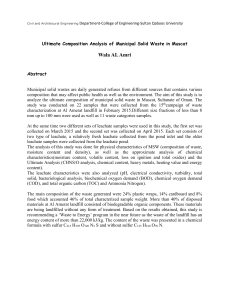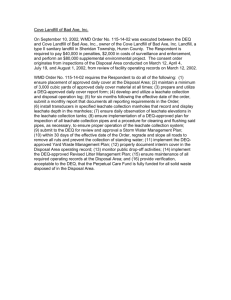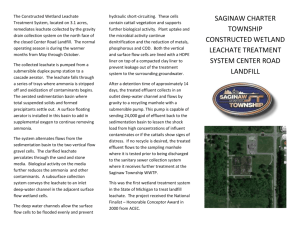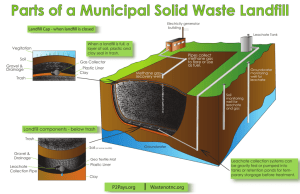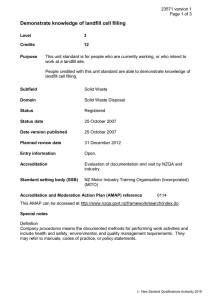Describe leachate, and operate and maintain a leachate collection and
advertisement
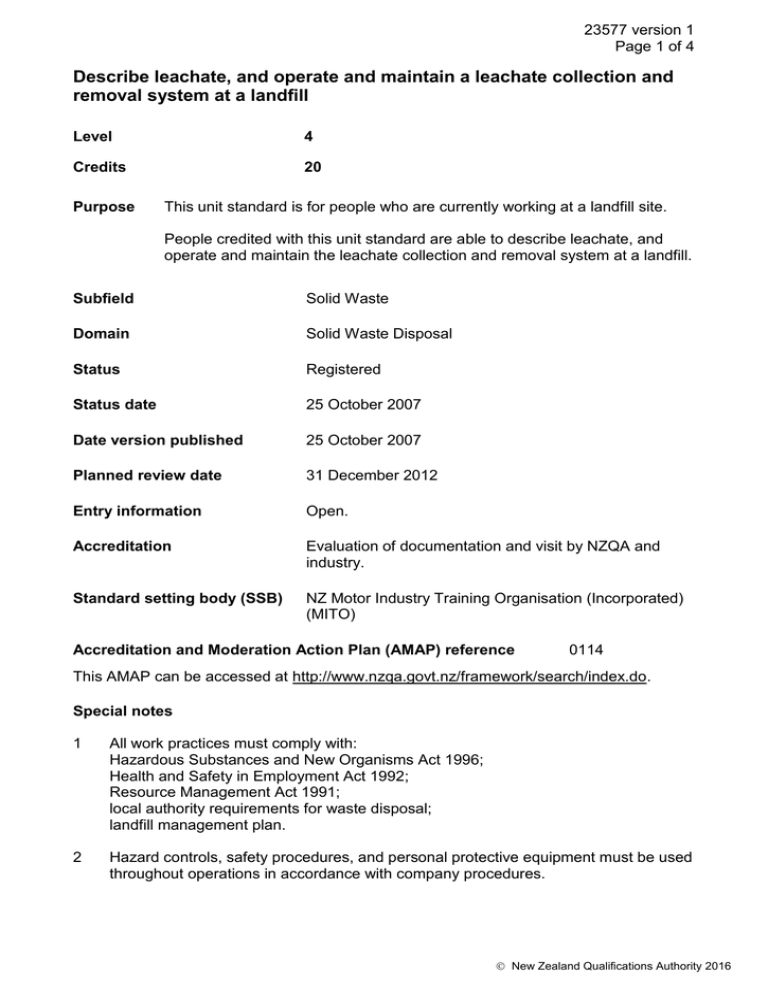
23577 version 1 Page 1 of 4 Describe leachate, and operate and maintain a leachate collection and removal system at a landfill Level 4 Credits 20 Purpose This unit standard is for people who are currently working at a landfill site. People credited with this unit standard are able to describe leachate, and operate and maintain the leachate collection and removal system at a landfill. Subfield Solid Waste Domain Solid Waste Disposal Status Registered Status date 25 October 2007 Date version published 25 October 2007 Planned review date 31 December 2012 Entry information Open. Accreditation Evaluation of documentation and visit by NZQA and industry. Standard setting body (SSB) NZ Motor Industry Training Organisation (Incorporated) (MITO) Accreditation and Moderation Action Plan (AMAP) reference 0114 This AMAP can be accessed at http://www.nzqa.govt.nz/framework/search/index.do. Special notes 1 All work practices must comply with: Hazardous Substances and New Organisms Act 1996; Health and Safety in Employment Act 1992; Resource Management Act 1991; local authority requirements for waste disposal; landfill management plan. 2 Hazard controls, safety procedures, and personal protective equipment must be used throughout operations in accordance with company procedures. New Zealand Qualifications Authority 2016 23577 version 1 Page 2 of 4 3 Assessment against this unit standard excludes leachate monitoring as described in Unit 23584, Demonstrate knowledge of environmental controls for landfills. 4 Definition Company procedures means the documented methods for performing work activities and include health and safety, environmental, and quality management requirements. They may refer to manuals, codes of practice, or policy statements. Elements and performance criteria Element 1 Describe leachate. Performance criteria 1.1 Leachate production is described in terms of factors influencing its generation. Range 1.2 Leachate is described in terms of its characteristics. Range 1.3 discharge – surface breakout, toe seepage, groundwater contamination. Leachate is described in terms of controlling migration. Range 1.6 effects – field capacity, migratory paths; types – to surface, to ground. Leachate is described in terms of causes and impacts of discharge. Range 1.5 major elements, trace elements, total organic compounds, microbiological components. Leachate migration is described in terms of effects and types. Range 1.4 degree of recirculation, precipitation, composition of refuse, topography, landfill cover, vegetation. site selection, storm water management, liner systems; liner systems include but are not limited to – clay, single synthetic, combined clay and synthetic composite, double composite. Leachate is described in terms of treatment and disposal systems. Range treatment includes but is not limited to – biological, physical, chemical, precipitation, air stripping, carbon absorption; disposal includes but is not limited to – discharge to waste water treatment plant, discharge to land, discharge to natural water course, recirculation with in the landfill, evaporation. Element 2 New Zealand Qualifications Authority 2016 23577 version 1 Page 3 of 4 Operate and maintain the leachate collection and removal system at a landfill. Performance criteria 2.1 The depth of leachate head on the landfill liner is maintained in accordance with local authority requirements. Range 2.2 depth is typically less than 300mm. Inputs into the system are controlled in accordance with company procedures. Range control includes – prohibiting bulk liquid waste from disposal at the site, location and quantity of controlled wastes. 2.3 Run-off and infiltrations of water to the system are limited in accordance with the landfill management plan and local authority requirements. 2.4 The leachate equipment is maintained in accordance with company procedures. Range 2.5 Leachate is disposed of in accordance with the landfill management plan and local authority requirements. Range 2.6 may include but is not limited to – flushing lines, cleaning sumps, pump maintenance, camera inspection. may include – recirculation, pretreatment, off-site disposal. Leachate control and disposal records are maintained in accordance with company procedures. Please note Providers must be accredited by NZQA, or an inter-institutional body with delegated authority for quality assurance, before they can report credits from assessment against unit standards or deliver courses of study leading to that assessment. Industry Training Organisations must be accredited by NZQA before they can register credits from assessment against unit standards. Accredited providers and Industry Training Organisations assessing against unit standards must engage with the moderation system that applies to those standards. New Zealand Qualifications Authority 2016 23577 version 1 Page 4 of 4 Accreditation requirements and an outline of the moderation system that applies to this standard are outlined in the Accreditation and Moderation Action Plan (AMAP). The AMAP also includes useful information about special requirements for organisations wishing to develop education and training programmes, such as minimum qualifications for tutors and assessors, and special resource requirements. Comments on this unit standard Please contact the NZ Motor Industry Training Organisation (MITO) info@mito.org.nz if you wish to suggest changes to the content of this unit standard. New Zealand Qualifications Authority 2016
